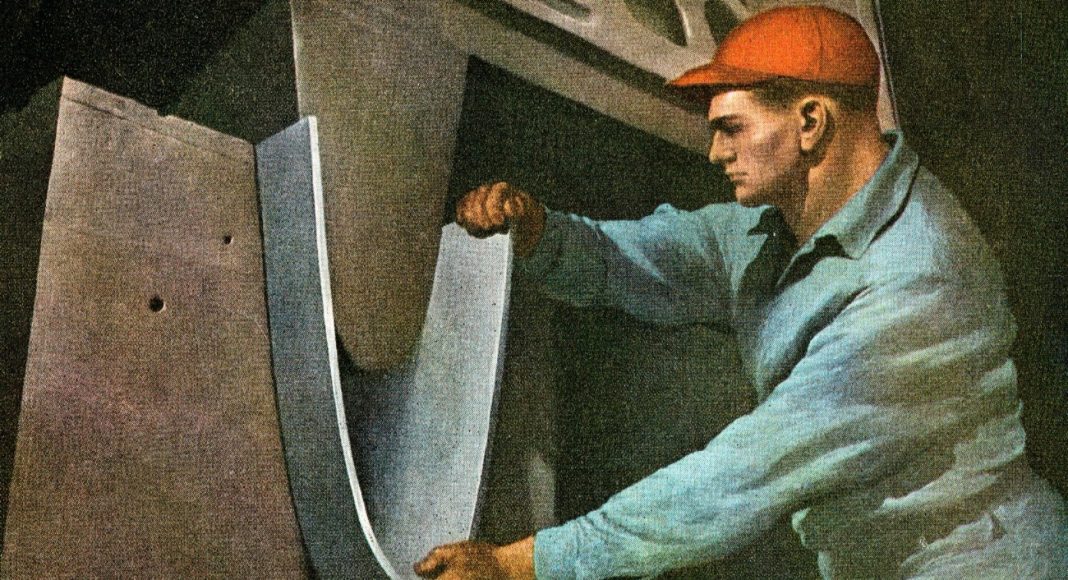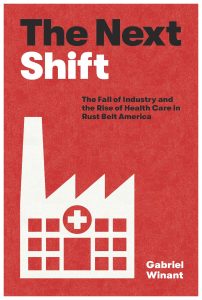In an excerpt from his new book The Next Shift, University of Chicago historian Gabriel Winant explores how deindustrialization and the decline of the working class contributed to America’s flawed health care system.
Editor’s note: The current debate in economics seems to lack a historical perspective. To try to address this deficiency, we decided to launch a Sunday column on ProMarket focusing on the historical dimension of economic ideas. You can read all of the pieces in the series here.
Over the postwar decades, employment in manufacturing underwent a long secular decline. Workers in industry after industry fell prey to some combination of automation, disinvestment, and capital flight, beginning as soon as the 1950s. Surface mining came to coal; decentralization and automation to auto assembly, electronics, and meatpacking; runaway shops to textiles; containerization to shipping; global trade competition to steel. Across the industrial areas of the country, communities secured through their attachment to these industries came under intensifying economic pressure.
This long dissolution of the industrial working class happened, however, in the context of the postwar welfare state. Across the industrial United States and the entire global North, working-class people responded to the secular crisis of manufacturing employment by making demands on state institutions, directly in political forms and indirectly through mass behavior as social service consumers. And across the entire deindustrializing world, a wave of welfare state expansion followed in the immediate aftermath, as governments responded to these demands and sought to manage the appearance of new forms of poverty amid the postwar plenty.
In the United States, we have not understood this political phenomenon as a single event but rather know it as a sequence: the War on Poverty, the Great Society, the urban uprisings, the welfare rights and Black Power movements, the Young Lords, labor’s rank-and-file rebellion, the fiscal crisis of the state, and stagflation. As displacement widened from a phenomenon confined to African Americans and Latinos across northern cities and white people in discrete pockets during the 1950s and 1960s to a general malady of the working class in the 1970s and 1980s, the problem expanded gradually from one of impoverished areas to a full-blown macroeconomic crisis. And it mobilized increasing state responses— albeit not all of one kind.
In health policy and economics, a substantial body of evidence shows that poverty, job loss and unemployment, aging populations, generous insurance policies, and well-capitalized health systems all may contribute to either poor population health, high rates of utilization of the health care system, or both. These phenomena of course may occur separately. But there exists a distinctive historical process that produced all of them together: deindustrialization.
The social formations left behind by manufacturing were—at the level of the population—disproportionately aged, sick, unemployed, impoverished, and yet relatively well insured. This generalization does not mean that each individual in a Rust Belt town was elderly, ailing, broke, and well insured, nor that the only way these phenomena occur is through deindustrialization. Nor, of course, does health trouble happen only by economic mechanisms or only to working-class people. Neither does old age affect only the dispossessed—particularly in a society enjoying lengthening life spans. Disproportionately large pockets of people in all these categories, however, could be found in various overlapping patterns, left behind as the legacy of manufacturing and the industrial workers’ welfare state. As manifested at the aggregate level, this demographic and economic configuration channeled the experience of job loss into the form of patient demand, flowing through the doors of the hospitals built up to serve the market formed by the insured working class. This process coincided with rising economic pressure on single-breadwinner households to bring in more wages, pushing women into the labor market and decoupling the rising demand for care from the supply of nonwaged care work that once helped to manage that demand—further speeding its flow into institutional settings.
With the secular crisis of industrial employment, the working-class population demanded more care. Women, increasingly pushed out of the nonwaged domestic sphere by economic pressure, were pulled into a booming labor market in care work. When women sought waged employment in the 1970s and 1980s, they entered a sector already long since cordoned off by the institutionalized racial and gendered logics of the postwar welfare state.
As the social reproduction of the working class became an increasingly vexed question, the preexisting system of subsidized health consumption elevated health institutions, turning them into prime points of access to care beyond the household. Because of the health care system’s fragmented, public-private structure—linking everyday, labor-intensive care provision to the profits of insurers, drug companies, and investors—and because of the system’s access to a market in the devalued labor of care workers, the health care system had the slack to accommodate rising demand for mass care. The public and privatized institutions of health provision established over the postwar years pumped income into working-class communities as other sources of security collapsed. While Medicare and collectively bargained programs were predominant, even Medicaid, the poor stepchild of health insurance, saw its budgetary footprint grow by almost half from 1981 to 1988—whereas the food stamp program, by comparison, shrank over the same period.
Rising social need thus met a relatively obliging health care system, which grew countercyclically to absorb the shock of industrial employment’s collapse. The institutions of social policy constructed between the 1930s and the 1960s worked to shunt the social crisis of deindustrialization into the health care system. At the bottom of the labor market, waged care work proliferated, responding to the process of industrial decline. In historical perspective, the process appears in close parallel to the rise of mass incarceration. Like the expansion of the prison system in the final decades of the twentieth century, the rise of the health care industry offered an economic fix to the social crisis brought about by deindustrialization, channeling public expenditure and state power into the management of surplus population, generating employment, profits, and social stability.
“Like the expansion of the prison system in the final decades of the twentieth century, the rise of the health care industry offered an economic fix to the social crisis brought about by deindustrialization.”
In this light, the relationship between the midcentury “egalitarian” period and our own time looks quite different. It was postwar liberalism that created the public-private welfare state that remains with us; that accepted the exclusion of huge categories of workers from social protection; that laid the groundwork for mass incarceration; that elevated the heteropatriarchal nuclear family into the only acceptable form of working-class household; that established widespread racial segregation in housing; that turned to financial markets to help policymakers govern through fiscal crisis; and that established a pluralist regime for labor law that could be captured by employers. Still traveling down this continuous historical path, we would be wrong to see the early twenty- first century as a return to the Gilded Age.
As a general rule, these compromises reflected apparent political necessity. In many cases, conservatives forced the settlement on liberals. We should not read these outcomes as evidence that the postwar welfare state was essentially “good” or “bad,” “exceptional” or “normal.” The point is not to exceptionalize what was distinctive about this period of history but to provincialize it: to see the factory worker, and the social order built around the factory worker, as embedded within larger and ongoing historical processes.
Industrial employment was the key node in the mesh of power governing and shaping a larger population, to which the formal employee was linked in hierarchical, asymmetrical relationships of interdependence through the family. But this arrangement deteriorated over time as factory workers lost their jobs, gradually turning an apparently narrow economic problem into a broadly social problem as it widened to destabilize a growing population. This later widespread instability, when deindustrialization manifested socially as a problem of populations of disposable and dependent people, allows us to look back and see how the New Deal state was always engaged in a project of securing, maintaining, reproducing, and ordering the life of the population. This project became evident when its basis eroded.
Health care as a site of employment expanded in the United States in ways roughly parallel to what happened in other wealthy capitalist democracies. Yet, in other wealthy societies undergoing deindustrialization, while health care employment grew, health care provision did not depart markedly from other aspects of welfare states; health care provision grew as welfare states did. In the American context, in contrast, the health care system stood virtually alone, booming dramatically alongside punitive social policy. Health care, because it was so deeply enmeshed in private markets and profitable accumulation opportunities, continued to attract public expenditure—albeit in increasingly warped and anomalous ways, as health care departed more and more from the economic ruination that surrounded and fed it. It is in this sense no coincidence that the United States began to depart markedly from other rich democracies in terms of health care spending only in the early 1980s, when the ax swung for the rest of the American welfare state.
Excerpted from The Next Shift: The Fall of Industry and the Rise of Health Care in Rust Belt America by Gabriel Winant, published by Harvard University Press. Copyright © 2021 by the President and Fellows of Harvard College. Used by permission. All rights reserved.
Learn more about our disclosure policy here.







